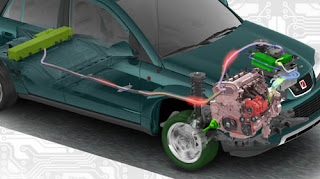 Save With Green recently had the opportunity to sample Dia'Mar Essential Health Product's full line of Copper skin care and Silver formulated all-natural skin therapy products. Previously unaware of the effective uses of Silver and Copper peptide skin care products, we can now say that Save With Green has been properly schooled and are very grateful to have come across Dia'Mar's innovatively healthy and holistic products - not to mention getting to use their skin therapy products for an extended period of time so we could see the benefits firsthand!
Save With Green recently had the opportunity to sample Dia'Mar Essential Health Product's full line of Copper skin care and Silver formulated all-natural skin therapy products. Previously unaware of the effective uses of Silver and Copper peptide skin care products, we can now say that Save With Green has been properly schooled and are very grateful to have come across Dia'Mar's innovatively healthy and holistic products - not to mention getting to use their skin therapy products for an extended period of time so we could see the benefits firsthand!First off, you may or may not already know that copper and silver both have many health benefits and a rich history in the medical field. Long used to fight off and kill a variety of pathogens and harmful bacteria, the medical use of Silver goes back thousands of years. Specifically, as early as 1900, Silver Nitrate - referred to as Argentum nitricum in modern day homeopathic cures - was prescribed by doctors to help cure stomach ulcers, and is often found in eye drops and homeopathic anti-anxiety medicines. Silver Water (which Dia'Mar offers on their website) is another popular and highly effective internal application of Silver thought to help mitigate cancer and kill dangerous bacteria. As for Copper, it has been used for its anti-inflammatory properties since Egyptian times. Helping the body produce super oxide dismutase - a therapeutic anti-inflammatory enzyme - Copper bracelets and copper jewelry continue to be worn today. Like Silver Water, it can also be internally taken as an ionic solution.
Copper and Silver make up the backbone of Dia'Mar's natural skin therapy products - and are essentially what helps make Dia'Mar such a unique company in the natural skin care industry. In addition to silver and copper, Dia-Mar uses whole leaf, cold pressed aloe in several of its natural skin therapy products. Being cold processed, there is no denaturing of naturally occurring enzymes, nor the breakdown of polysaccharides. And best of all, Dia'Mar's silver and copper skin care products are truly all-natural, being derived from naturally occurring amino acids (the building blocks of protein) and active ingredient extracts. Furthermore, they are free of parabens, animal-based products, artificial color, GMO, alcohol and artificial fragrance. In fact, there is no fragrance in their skin therapy products at all - something which we found very refreshing. Couple this with the refreshing, clean and rejuvenating feeling your skin will feel, and you'll be ready to write a glowing review yourself!
The full line of natural skin care products offered by Dia'Mar consists of five different skin creams and gels. Copper skin care products include "Copper Skin Therapy", "Copper Scar Cream", "Copper Sports Rub" and "2nd Debut" moisturizing cream. Silver skin care products include a comprehensive, all-in-one topical gel called "Silver Skin Therapy". All products are briefly discussed below:
Copper Skin Therapy - a comprehensive, fast absorbing topical gel designed to treat skin deeply while leaving it smooth and soft, Copper Skin Therapy is designed to help skin retain moisture while mitigating the effects of aging. Copper helps in repairing the skins outer layer by helping form bone hemoglobin and red blood cells. In combination with vitamin C and zinc, it also helps to form vital skin proteins - collagen and elastin. More specifically, it is small fragments of proteins (peptides) that bind to copper and take an active role in renewing skin cells, thereby helping to reduce wrinkles. Best of all, there is no skin irritation, which is often the case for other wrinkle-removing skin care products. Other active ingredients in Dia'Mar's copper peptide skin care include Sodium Hyaluronate for preserving skin moisture, and Allantoin for healing blemishes/acne and reducing fine lines. My wife especially enjoyed the fact that, due to the fast absorbent rate of copper skin therapy, makeup can be applied over it.
Silver Skin Therapy - With the intent of relieving, swelling, itching and healing skin irritations, allergic skin reactions, sun burns, rashes, minor cuts and burns, Silver Skin Therapy is an excellent remedial topical gel for sensitive and damaged skin prone to infection. The primary active ingredients are ionic silver, allantoin and aloe. Aloe has been medicinally used since ancient times and is even listed by the US Pharmacopoeia as a certified skin protectant. Containing at least six different antiseptic agents and three anti-inflammatory fatty acids, aloe helps to speed up the healing process while relieving discomfort. The addition of allantoin further helps promote healing, cell regeneration and softer, smoother skin. Staying true to its namesake, Dia'Mar's Silver Skin Therapy contains ionic silver for killing bacteria and viruses.
2nd Debut - Dia'Mar's signature anti-aging copper skin cream, 2nd Debut proved to be one of our favorite skin therapy products. Fast absorbing, scentless and free of any oily residue, 2nd Debut Copper skin cream is highly effective at giving a more youthful glow and repairing wrinkles and fine lines. Specifically, in combination with Vitamin C and Zinc, copper and wheat peptides (protein fragments) help to stimulate collagen formation, which helps firm the skin and diminish fine lines - the main focus of copper skin care products. The addition of rice bran oil, which is commonly used by Japanese women, helps smooth and soften the skin. Last but not least, allantoin, which is found in many anti-acne and clarifying lotions, helps heal blemishes and repair wrinkles.
Copper Scar Cream - Considering copper's vital role in repairing the skin's outer layer, it makes sense to use it for treating scars. In fact, Dia'Mar's Copper Scar Cream was developed under the guidance of a reconstructive surgeon. In combination with herb-infused aloe, rose hip seed oil, rosemary oil and lavender oil, Copper Scar Cream helps to smooth and blend scars with the surrounding skin, while reducing redness and inflammation. Other active ingredients include allantoin to promote cell regeneration, zinc and Vitamin C.
Copper Sports Rub - Truly one of the best all natural sports rubs available, Dia'Mar's Copper Sports Rub goes several steps further in relieving muscle stiffness and swelling than conventional sports rubs. Physician formulated, Copper Sports Rub contains camphor, menthol and Methysulfonylmethane (MSM). The use of camphor and menthol is common in many sports rubs. However, the addition of Copper and MSM, make this an exceptional sports rub. As we learned on Dia'Mar's website, Dia-mar.net, (the source for most of the facts presented in this review), MSM is a naturally occurring sulfur compound found in the human body and which can be derived from the ocean. It specifically works to reduce inflammation and discomfort by equalizing pressure inside and outside of cellular walls.
If you are interested in trying these outstanding copper skin care products for yourself, head on over to Dia-Mar.net. Unlike other skin therapy products promising to administer magical cures with digitally retouched before and after photos, you will get unbiased and straight-forward facts at Dia-Mar. All of their products sell for under $20 (except for Silver Skin Therapy, which goes for $24.95). And again, there are no artificial colors, GMO's, artificial fragrance, alcohol, animal bi-products or artificial preservatives in Dia'mar's skin therapy products. -savewithgreen




































